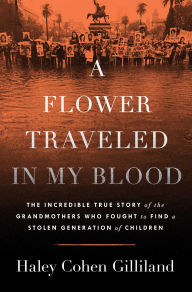The Truth, Before Anything: A Guest Post by Haley Cohen Gilliland
A harrowing and ultimately hopeful story of the most unlikely heroism in the face of tragedy. This is history that sings, written in the incisive tone of a thriller. Read on for an exclusive essay from Haley Cohen Gilliland on writing A Flower Traveled in My Blood.
A Flower Traveled in My Blood: The Incredible True Story of the Grandmothers Who Fought to Find a Stolen Generation of Children
A Flower Traveled in My Blood: The Incredible True Story of the Grandmothers Who Fought to Find a Stolen Generation of Children
In Stock Online
Hardcover
$27.00
$30.00
A remarkable new talent in narrative nonfiction delivers the epic true story of a group of courageous grandmothers who fought to find their grandchildren who were stolen.
A remarkable new talent in narrative nonfiction delivers the epic true story of a group of courageous grandmothers who fought to find their grandchildren who were stolen.
As I took the creaking elevator up to the 6th floor and knocked on the door of apartment 15, my stomach clenched. I had read about Rosa Roisinblit for months, and now I was finally going to get to meet her in person.
It was November of 2021, and for the previous nine months, I had thrown myself into researching Rosa and the other Abuelas de Plaza de Mayo, a courageous group of grandmothers who united to reclaim the grandchildren stolen from them by the armed forces during Argentina’s 1976-1983 military dictatorship. But their story had grabbed me long before I found myself in front of Rosa’s door.
I had first learned of the Abuelas in 2011, when I moved to Argentina for a research fellowship that eventually turned into several years working as a foreign correspondent, covering Argentina and Uruguay for The Economist. Upon arrival, I hoovered up newspapers and Argentine history books to get my bearings and was shocked by what I read. I knew that the Argentine military had disappeared thousands of people during the 1976 to 1983 dictatorship, but I was not aware that among them were hundreds of pregnant women. The soon-to-be mothers were held in detention until giving birth and then quietly killed, their babies gifted to other families to raise under false identities.
I became obsessed with the Abuelas, the grandmothers who banded together to find those stolen babies. I read everything I could about them, and was surprised when I could only find one English-language book dedicated to their incredible history. It was thoroughly reported, but more of an academic treatment than a narrative history of the type I had always loved reading. I was only twenty-two at the time, and did not yet have the confidence or experience to tackle such an ambitious project myself, but the desire to learn about the Abuelas never fully left me. Years later, during a conversation with fellow history enthusiast friends who admitted they had never heard of the Abuelas, the desire to research the Abuelas washed over me again with tsunami force. The book I’d once wanted to read, I urgently wanted to write.
Which was how, barely two weeks after Argentina reopened to foreigners after its stringent COVID lockdown, I found myself in Rosa Roisinblit’s cozy apartment, which was decorated with patterned upholstery, a profusion of houseplants, and endless photos of her only child, Patricia Julia Roisinblit, who was disappeared by the armed forces in 1978 at eight months pregnant. After desperately searching alone for a few months, Rosa joined the Abuelas and had been at the center of their movement ever since. Though she had recently celebrated her 102nd birthday, she was still involved, attending their weekly meeting when she felt well enough.
For the next hour, we spoke about her daughter’s disappearance and her long and painful search for her grandchild. At one point, I apologized for asking her to relive such traumatic moments from her past. She paused and said, “When someone comes and wants to hear the story, they come here and I tell it. It’s not easy, but it’s better that it be known, because I’m going to tell the truth.” Later on, she repeated the sentiment for emphasis: “I have always told my story exactly as it is. Nothing more. The truth, before everything.”
Those interactions set the tone for the entire project. All I had to do to write a gripping narrative, I realized, was to report until I could recount the Abuelas’ history exactly as it happened. Doing that required nearly five years, during which I conducted original interviews, scoured archives, tracked down court recordings, and studied hundreds of books and academic articles. I personally visited as many sites described in the book as possible, spending uneasy hours roaming the dark halls of the ESMA detention center and far more pleasant ones touring the spotless laboratories of the Banco Nacional de Datos Genéticos, where the Abuelas’ genetic information is compared to that of their possible grandchildren.
I wrote this book for a simple reason: so that people know–and remember–the story of the Abuelas de Plaza de Mayo. I had no agenda beyond that. But when readers shut the book’s back cover, I hope that they feel as inspired by the Abuelas as I did by writing about them.

